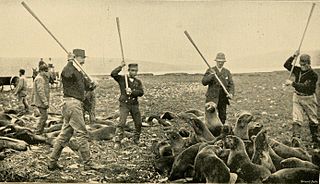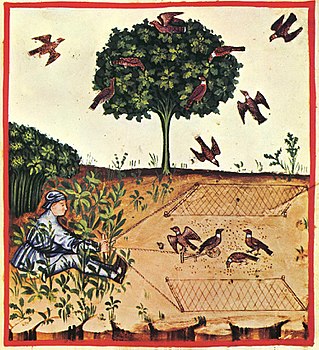
Mink are dark-colored, semiaquatic, carnivorous mammals of the genera Neogale and Mustela and part of the family Mustelidae, which also includes weasels, otters, and ferrets. There are two extant species referred to as "mink": the American mink and the European mink. The extinct sea mink was related to the American mink but was much larger.

Animal welfare is the well-being of non-human animals. Formal standards of animal welfare vary between contexts, but are debated mostly by animal welfare groups, legislators, and academics. Animal welfare science uses measures such as longevity, disease, immunosuppression, behavior, physiology, and reproduction, although there is debate about which of these best indicate animal welfare.

Fur farming is the practice of breeding or raising certain types of animals for their fur.

Seal hunting, or sealing, is the personal or commercial hunting of seals. Seal hunting is currently practiced in nine countries: Canada, Denmark, Russia, the United States, Namibia, Iceland, Norway, Finland and Sweden. Most of the world's seal hunting takes place in Canada and Greenland.

Fur clothing is clothing made from the preserved skins of mammals. Fur is one of the oldest forms of clothing and is thought to have been widely used by people for at least 120,000 years. The term 'fur' is often used to refer to a specific item of clothing such as a coat, wrap, or shawl made from the fur of animals.

Alberta's Métis people are descendants of mixed First Nations/Indigenous peoples and White/European families. The Métis are considered an aboriginal group under Canada's Constitution Act, 1982. They are separate and distinct from First Nations, though they live in the same regions and have cultural similarities, and have different legal rights.
The Humane Society of the United States (HSUS) is an American nonprofit organization that focuses on animal welfare and opposes animal-related cruelties of national scope. It uses strategies that are beyond the abilities of local organizations. It works on issues including pets, wildlife, farm animals, horses and other equines, and animals used in research, testing and education. As of 2001, the group's major campaigns targeted factory farming, hunting, the fur trade, puppy mills, and wildlife abuse.
The Animal Welfare Institute (AWI) is an American non-profit charitable organization founded by Christine Stevens in 1951 with the goal of reducing suffering inflicted on animals by humans. It is one of the oldest animal welfare organizations in the US. Its legislative division, the Society for Animal Protective Legislation (SAPL), pushes for the passage of laws that reflect this purpose.

Animal trapping, or simply trapping or ginning, is the use of a device to remotely catch an animal. Animals may be trapped for a variety of purposes, including food, the fur trade, hunting, pest control, and wildlife management.
Humane Society International (HSI) is the international division of The Humane Society of the United States. Founded in 1991, HSI has expanded The HSUS's activities into Central and South America, Africa, and Asia. HSI's Asian, Australian, Canadian, and European offices carry out field activities and programs.

In the fur trade, a trapline is a route along which a trapper sets traps for their quarry. Trappers traditionally move habitually along the route to set and check the traps, in so doing become skilled at traversing remote terrain, and become experts in the geography of the local area. Because of this traditional knowledge, traplines are not only of interest to trappers themselves but to researchers and others interested in local history, biology, and topography. The assignment of particular trapline territories to individuals in band societies was traditionally handled by group consensus, and occasionally violence and warfare. In the present-day trapline assignment is typically formalized and controlled by the state. Formalized trapline territory boundaries now form the basis for many major land-use projects in fur-rich regions.
The Agreement on International Humane Trapping Standards (AIHTS) establishes the required standards for approval and certification of animal trapping devices.

Deadfalls and Snares: A Book of Instruction for Trappers About These and Other Home-Made Traps is a 1907 book by A. R. Harding.

Animal welfare in New Zealand is governed by the Animal Welfare Act 1999 and a number of organisations actively advocate for both animal welfare and animal rights. Pest control and farming practices have been scrutinised with respect to animal welfare issues. The legality of killing dogs and cats for consumption has also been criticized.

Humane Society International Australia (HSIA) is the Australian branch of Humane Society International (HSI), an offshoot of the international animal protection organisation, the Humane Society of the United States (HSUS).
Animal welfare in the United States relates to the treatment of non-human animals in fields such as agriculture, hunting, medical testing and the domestic ownership of animals. It is distinct from animal conservation.
Animal welfare and rights in Canada is about the laws concerning and treatment of nonhuman animals in Canada. Canada has been considered to have weak animal welfare protections by the organization World Animal Protection. The vast majority of Canadians are for further animal protections, according to a poll conducted on behalf of Mercy for Animals.
Animal welfare and rights in South Africa is about the treatment of and laws concerning non-human animals in South Africa.
Animal welfare and rights in Denmark relates to the treatment of and laws concerning non-human animals in Denmark. Denmark has moderately strong protections for animals by international standards. In 2014 and again in 2020, Denmark received a B grade on the A–G scale of the World Animal Protection's Animal Protection Index.










